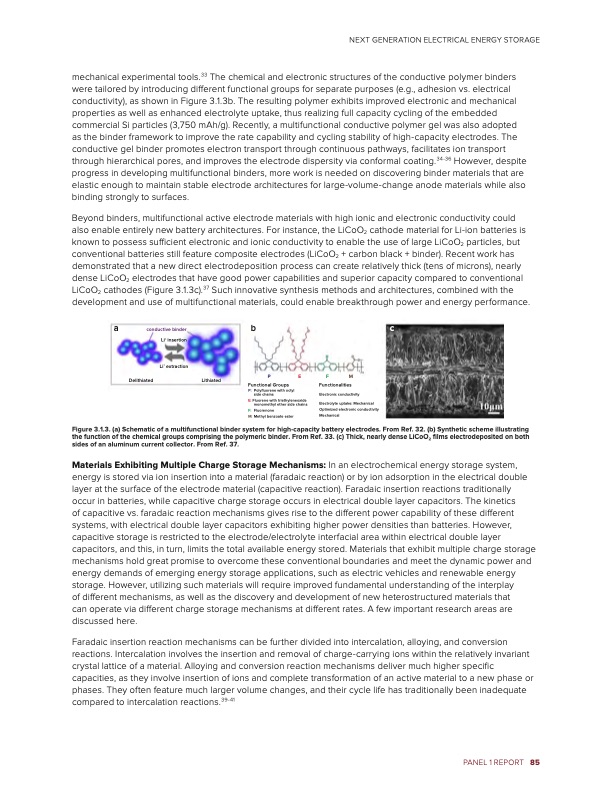
PDF Publication Title:
Text from PDF Page: 091
mechanical experimental tools.33 The chemical and electronic structures of the conductive polymer binders were tailored by introducing different functional groups for separate purposes (e.g., adhesion vs. electrical conductivity), as shown in Figure 3.1.3b. The resulting polymer exhibits improved electronic and mechanical properties as well as enhanced electrolyte uptake, thus realizing full capacity cycling of the embedded commercial Si particles (3,750 mAh/g). Recently, a multifunctional conductive polymer gel was also adopted as the binder framework to improve the rate capability and cycling stability of high-capacity electrodes. The conductive gel binder promotes electron transport through continuous pathways, facilitates ion transport through hierarchical pores, and improves the electrode dispersity via conformal coating.34-36 However, despite progress in developing multifunctional binders, more work is needed on discovering binder materials that are elastic enough to maintain stable electrode architectures for large-volume-change anode materials while also binding strongly to surfaces. Beyond binders, multifunctional active electrode materials with high ionic and electronic conductivity could also enable entirely new battery architectures. For instance, the LiCoO2 cathode material for Li-ion batteries is known to possess sufficient electronic and ionic conductivity to enable the use of large LiCoO2 particles, but conventional batteries still feature composite electrodes (LiCoO2 + carbon black + binder). Recent work has demonstrated that a new direct electrodeposition process can create relatively thick (tens of microns), nearly dense LiCoO2 electrodes that have good power capabilities and superior capacity compared to conventional LiCoO2 cathodes (Figure 3.1.3c).37 Such innovative synthesis methods and architectures, combined with the development and use of multifunctional materials, could enable breakthrough power and energy performance. Delithiated Lithiated PEFM Functional Groups P: Polyfluorene with octyl side chains E: Fluorene with triethyleneoxide monomethyl ether side chains F: Fluorenone M: Methyl benzoate ester Functionalities Electronic conductivity Electrolyte uptake: Mechanical Optimized electronic conductivity Mechanical Figure 3.1.3. (a) Schematic of a multifunctional binder system for high-capacity battery electrodes. From Ref. 32. (b) Synthetic scheme illustrating the function of the chemical groups comprising the polymeric binder. From Ref. 33. (c) Thick, nearly dense LiCoO2 films electrodeposited on both sides of an aluminum current collector. From Ref. 37. Materials Exhibiting Multiple Charge Storage Mechanisms: In an electrochemical energy storage system, energy is stored via ion insertion into a material (faradaic reaction) or by ion adsorption in the electrical double layer at the surface of the electrode material (capacitive reaction). Faradaic insertion reactions traditionally occur in batteries, while capacitive charge storage occurs in electrical double layer capacitors. The kinetics of capacitive vs. faradaic reaction mechanisms gives rise to the different power capability of these different systems, with electrical double layer capacitors exhibiting higher power densities than batteries. However, capacitive storage is restricted to the electrode/electrolyte interfacial area within electrical double layer capacitors, and this, in turn, limits the total available energy stored. Materials that exhibit multiple charge storage mechanisms hold great promise to overcome these conventional boundaries and meet the dynamic power and energy demands of emerging energy storage applications, such as electric vehicles and renewable energy storage. However, utilizing such materials will require improved fundamental understanding of the interplay of different mechanisms, as well as the discovery and development of new heterostructured materials that can operate via different charge storage mechanisms at different rates. A few important research areas are discussed here. Faradaic insertion reaction mechanisms can be further divided into intercalation, alloying, and conversion reactions. Intercalation involves the insertion and removal of charge-carrying ions within the relatively invariant crystal lattice of a material. Alloying and conversion reaction mechanisms deliver much higher specific capacities, as they involve insertion of ions and complete transformation of an active material to a new phase or phases. They often feature much larger volume changes, and their cycle life has traditionally been inadequate compared to intercalation reactions.39-41 NEXT GENERATION ELECTRICAL ENERGY STORAGE a conductive binder b Li+ insertion Li+ extraction c PANEL 1 REPORT 85PDF Image | Next Generation Electrical Energy Storage

PDF Search Title:
Next Generation Electrical Energy StorageOriginal File Name Searched:
BRN-NGEES_rpt-low-res.pdfDIY PDF Search: Google It | Yahoo | Bing
Sulfur Deposition on Carbon Nanofibers using Supercritical CO2 Sulfur Deposition on Carbon Nanofibers using Supercritical CO2. Gamma sulfur also known as mother of pearl sulfur and nacreous sulfur... More Info
CO2 Organic Rankine Cycle Experimenter Platform The supercritical CO2 phase change system is both a heat pump and organic rankine cycle which can be used for those purposes and as a supercritical extractor for advanced subcritical and supercritical extraction technology. Uses include producing nanoparticles, precious metal CO2 extraction, lithium battery recycling, and other applications... More Info
| CONTACT TEL: 608-238-6001 Email: greg@infinityturbine.com | RSS | AMP |